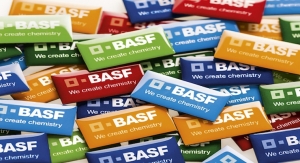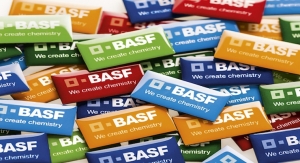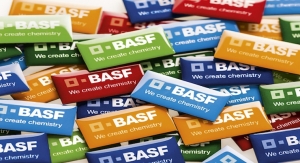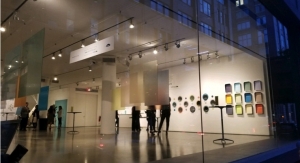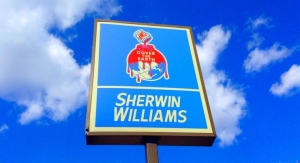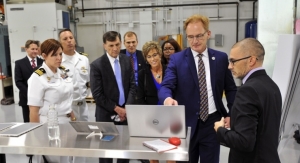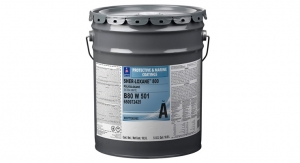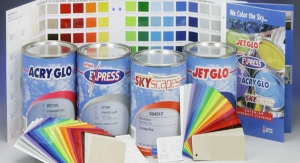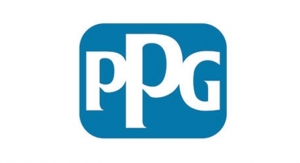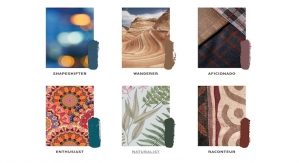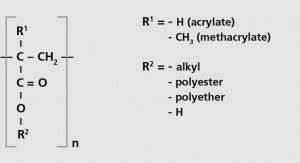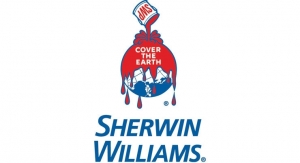10.03.18
The 2018 Sherwin-Williams Impact Award, which recognizes outstanding water and wastewater projects, goes to a 3-million-gallon water storage tank restoration project performed under difficult conditions.
Crewmembers from Vancouver, Washington-based HCI Industrial & Marine Coatings Inc. had to battle smoke from the nearby Eagle Creek fire and prevent that smoke from absorbing into the interior tank coating and affecting the taste of water stored in the tank. For their efforts, HCI, the city of The Dalles, Oregon, and engineering services provider CH2M Inc. (locally based in Corvallis, OR) earned the 2018 Sherwin-Williams Impact Award.
The award recognizes notable projects featuring coating and lining materials from Sherwin-Williams Protective & Marine Coatings. The company announced the winners during a ceremony at the Water Environment Federation’s Annual WEFTEC Conference on Oct. 2, 2018, in New Orleans, Louisiana.
“We established the Sherwin-Williams Impact Award to honor demanding water and wastewater projects and recognize those professionals committed to enhancing public safety, protecting assets, and extending infrastructure life,” said Kevin Morris, market segment director, Water & Wastewater, Sherwin-Williams Protective & Marine Coatings. “The winning project faced unique challenges that none of the parties involved had ever encountered. We all worked together to devise a plan that would ensure adhesion of the water tank’s coating systems and prevent smoke from adversely impacting the community’s water quality.”
Located about 70 miles west of the storage tank site, the 2017 Eagle Creek fire burned more than 50,000 acres over three months and resulted in additional challenges for the project team. Smoke was prone to being sucked into the cut-out access entry for the tank, presenting air quality concerns during work, as well as potential contamination to the lining. Using monitoring data, the HCI crew avoided applying coatings during hours in which particulate matter readings were above established thresholds. In addition, the team had to conduct wipe tests after each coat cured, using clean white cloths to check for PM before applying the subsequent coat. If a test showed evidence of smoke deposits, the crew had to clean the surface before applying the next coat.
To restore the tank’s interior, HCI crewmembers first set up an air filtering system to minimize as much smoke inside the tank as possible. Next, they prepared the entire tank interior surface before spray-applying multiple layers of Sherwin-Williams Macropoxy 5500LT, a high-solids, polyamidoamine epoxy tank lining developed for potable water storage tanks. The layers included a prime coat, a stripe coat on all weld seams to ensure a higher film build, an intermediate coat, and a topcoat.
HCI also followed the PM guidelines to ensure strong adhesion of the exterior coating system, which included applying a direct-to-metal prime coat and an intermediate coat of Sherwin-Williams Pro Industrial Pro-Cryl Universal Acrylic Primer. For the topcoat, the crew applied one to two coats of Sher-Cryl HPA, a high-performance acrylic semi-gloss coating from Sherwin-Williams, with the second coat applied selectively to sharp edges for a higher film build.
“Through careful planning, attention to detail, and open communication, HCI was able to complete a successful tank restoration for the city of The Dalles,” said Morris. “The entire team faced the impact of smoke from a destructive wildfire to ultimately arrive at a restored water tank that will store uncontaminated water for the city for years to come.”
The co-runner-up projects for the 2018 Impact Award include protective concrete coating applications performed at a 25-million-gallon-per-day secondary treatment plant and an intermediate overcoat solution for an elevated water tank.
First, Santa Fe Springs, California-based Cor-Ray Painting Co. completed extensive concrete coatings applications for the expansion of the South Bay International Wastewater Treatment Plant (SBIWTP) in San Diego, California. Global engineering, procurement, construction, and consulting company Black & Veatch served as construction manager and coatings inspector for the project. The Cor-Ray Painting crew applied Sherwin-Williams Steel-Seam FT910 Epoxy Patching and Surfacing Compound to fill large voids in the concrete surfaces. Crewmembers then spray-applied Corobond 100 Epoxy Primer/Sealer from Sherwin-Williams, followed by two coats of Dura-Plate 6100 High-Performance Epoxy, before sealing all joint surfaces using an elastomeric joint sealant.
The second co-runner-up project is the intermediate restoration of a dilapidated 1-million-gallon elevated water storage tank in Houma, Louisiana. Terrebonne Parish Consolidated Waterworks District No. 1 and Sherwin-Williams devised a plan to use an overcoat system that would revive the rusted appearance of the tank and extend the life of the existing coating system until the utility is able to fully restore the tank. A three-man, in-house maintenance crew completed the project efficiently and cost-effectively, applying Macropoxy 646 Fast Cure Epoxy, Macropoxy 920 Pre-Prime, and two gloss white coats of Pro Industrial DTM Acrylic using an airless pump with a custom power roller assembly.
Taking home an honorable mention in this year’s competition is a project involving extensive repairs and restorations performed on a 7.5-million-gallon water storage tank and two water treatment plant clarifiers for the Benton/Washington Regional Public Water Authority (BWRPWA). Glenpool, Oklahoma-based Kimery Painting Inc. (KPI) handled the rehabilitation with Little Rock, Arkansas-based Crist Engineers Inc. serving as the project engineering firm. For the water tank interior, KPI crewmembers spray-applied a hold primer and stripe coat, before spraying a topcoat of high-build SherPlate PW Epoxy coating to ensure a long-lasting lining system. For the tank’s exterior, the crew applied a three-coat system using a primer, intermediate coat of Macropoxy 646 Fast Cure Epoxy, and a topcoat of Hi-Solids Polyurethane MR. To address the two clarifiers, the KPI crew restored steel surfaces and then applied two coats of Macropoxy 646.
The Sherwin-Williams Impact Award program recognizes application contractors, specifiers, and owners for excellence on North American water and wastewater projects that influence public safety, asset protection, and infrastructure lifecycle improvement. Eligible projects included any water-related structure that was new, restored, and/or rehabilitated in 2017 and was completed using coating and lining materials from Sherwin-Williams Protective & Marine Coatings.
2018 SHERWIN-WILLIAMS IMPACT AWARD WINNER: HCI INDUSTRIAL & MARINE COATINGS INC., CH2M INC., AND THE CITY OF THE DALLES, OREGON – 3-MILLION-GALLON WATER STORAGE TANK RESTORATION IN THE DALLES, OREGON
Most potable water storage tank restoration projects do not come with the need to monitor atmospheric particulate matter to prevent smoke from contaminating the new tank lining. But the 2017 restoration of the 3-million-gallon Columbia View Reservoir storage tank for the city of The Dalles, Oregon, wasn’t like most projects. Crewmembers from Vancouver, Washington-based HCI Industrial & Marine Coatings Inc. had to battle smoke from a nearby wildfire during the restoration, while trying to prevent a potential smoky odor in the interior coating that could affect the taste of water stored in the tank. Their efforts earned HCI, the city of The Dalles, and engineering services provider CH2M Inc. (locally based in Corvallis, Oregon) top honors for the 2018 Sherwin-Williams Impact Award.
The Eagle Creek Fire erupted on Sept. 2, 2017, burning more than 50,000 acres in the Columbia River Gorge in Oregon and Washington over the course of three months. HCI had just commenced the Columbia View Reservoir storage tank restoration process about 70 miles east of the fire, and downwind smoke became a frequent nuisance for applicators. Smoke was prone to being sucked into the cut-out access entry for the tank, presenting air quality concerns during interior blasting and application steps, as well as potential contamination of the lining. Similar air quality issues affected the crew when restoring the tank’s exterior, only without the worry of contaminating potable water.
None of the parties, including Sherwin-Williams technical representatives, had ever encountered this type of situation. They worked together to devise a plan to protect the quality of the project by ensuring the adhesion of the coating system and preventing smoke contamination in the interior coating to avoid adversely impacting water quality.
Based on the plan, HCI applicators were permitted to move forward with blasting and coating – but with restrictions based on hourly air quality readings. Using monitoring data provided by the Oregon Department of Environmental Quality (DEQ), the crew avoided applying coatings during hours in which PM2.5 readings – a measure of atmospheric PM that has a diameter of fewer than 2.5 micrometers – were below established thresholds. For the prime and intermediate coats, the one-hour PM2.5 could not be greater than 35 micrograms (μg)/m³ (100 AGI). To prevent smoke odor contamination within the topcoat, applicators had to ensure the one-hour PM2.5 readings were no greater than 20 μg/m³ (67 AGI).
To restore the tank’s interior, HCI crewmembers first set up an air filtering system to minimize as much smoke inside the tank as possible. Next, they prepared the entire tank interior, abrasive-blasting it to an SSPC-SP5 surface before applying coatings. Using Sherwin-Williams Macropoxy 5500LT, a high-solids, polyamidoamine epoxy tank lining developed for potable water storage tanks, crewmembers spray-applied a 4-mil minimum dry film thickness (MDFT) prime coat in white. Next, they applied a 3-mil MDFT stripe coat of light blue Macropoxy 5500LT on all weld seams to ensure a higher film build on these rougher areas. For the intermediate coat, the crew coated the entire interior with a 4-mil MDFT application of light blue Macropoxy 5500LT. Finally, the crew sprayed the top coat of Macropoxy 5500LT in white at 4 mils MDFT. The final lining system, therefore, had a 12-mil MDFT on all non-stripe-coated areas and a 15-mil MDFT on all stripe-coated areas. The alternating colors enabled the crew to ensure complete coverage of each coat.
For the tank’s exterior, smoke contamination was less of an issue, as it wouldn’t affect water quality. Still, HCI followed the PM guidelines to ensure strong adhesion of the coating system. To restore the exterior, the crew abrasive-blasted the steel tank to an SSPC-SP11 surface. They next applied a direct-to-metal prime coat of Sherwin-Williams Pro Industrial Pro-Cryl Universal Acrylic Primer at 3 mils MDFT, followed by an additional 1.8- to 3.6-mil DFT coat of the self-crosslinking acrylic primer after the base layer cured. For the topcoat, they applied one to two coats of Sher-Cryl HPA, a high-performance acrylic semi-gloss coating from Sherwin-Williams, at 2.5-4 mils DFT per coat, with the second coat applied to sharp edges for a higher film build.
After each coat cured throughout the project, crewmembers conducted a wipe test, using a clean white cloth to check for PM before applying the subsequent coat. If a test showed evidence of smoke deposits, the crew had to clean the surface before applying the next coat.
As part of its quality control process, the city of The Dalles logged the DEQ’s one-hour PM2.5 data during each hour that coating activity took place, noting which section of the tank was coated during that time. If a lining or exterior coating failure were to occur in the future, this data would allow the city to determine if smoke levels may have been the cause.
Through careful planning, attention to detail, and open communication, HCI was able to complete a successful tank restoration for the city of The Dalles. The entire team faced the unprecedented impact of smoke from a destructive wildfire to ultimately arrive at a restored water tank that will house uncontaminated water for the city for years to come.
2018 SHERWIN-WILLIAMS IMPACT AWARD RUNNER-UP: COR-RAY PAINTING CO., BLACK & VEATCH, AND INTERNATIONAL BOUNDARY AND WATER COMMISSION – SOUTH BAY INTERNATIONAL WASTEWATER TREATMENT PLANT EXPANSION IN SAN DIEGO, CALIFORNIA
A project involving extensive protective concrete coating applications for the expansion of the South Bay International Wastewater Treatment Plant (SBIWTP) in San Diego, California, earned a co-runner-up distinction for the 2018 Sherwin-Williams Impact Award. Santa Fe Springs, California-based Cor-Ray Painting Co. completed the SBIWTP infrastructure improvements for the U.S. International Boundary and Water Commission (USIBWC). Global engineering, procurement, construction, and consulting company Black & Veatch served as construction manager and coatings inspector for the project.
The originally specified system for the project called for applying a full coat of a water-based epoxy cementitious resurfacer to concrete surfaces, followed by three subsequent steps of applying epoxy mortar and epoxy seal coats. However, Cor-Ray Painting proposed a specification change to the Sherwin-Williams Dura-Plate 6100 system, as it offered a faster, more efficient installation. Dura-Plate 6100 is a 100% solids high-build, high physical performance, amine-cured epoxy designed for corrosion protection of concrete and steel in municipal and industrial wastewater treatment facilities. Compared to the originally specified system, Dura-Plate 6100 offered a faster dry-to-touch time – which reduced the potential for outgassing from concrete – as well as a faster return-to-service time of just six hours, which reduced downtime and increased productivity. In addition, the high-build properties of Dura-Plate 6100 enabled applicators to create a thick, monolithic lining that used existing bugholes in the concrete as structural anchor points to improve adhesion of the entire lining system.
The SBIWTP is a 25-million-gallon-per-day secondary treatment plant that treats sewage originating in Tijuana, Mexico. The plant’s expansion included a new secondary sediment tank, as well as new equalization basins, and influent and effluent channels. To apply protective concrete coatings to these assets, the Cor-Ray Painting crew first abrasive-blast cleaned the concrete surfaces per SSPC-SP13 guidelines to deliver an ICRI 310.2 concrete surface profile (CSP) of 4-6 with light to medium scarification. The resulting prepared surface promoted strong adhesion of the soon-to-be-applied coating system.
To coat the concrete, the Cor-Ray Painting crew first applied Sherwin-Williams Steel-Seam FT910 Epoxy Patching and Surfacing Compound by trowel as needed to fill larger surface voids. Crewmembers then primed concrete surfaces by spray-applying Corobond 100 Epoxy Primer/Sealer from Sherwin-Williams at 4-8 mils dry film thickness (DFT). The penetrating primer will help to prevent future blow-back and outgassing from the concrete substrate. To ensure complete coverage, the crew used a heavy nap roller to back roll the spray-applied primer into the concrete’s pores before spraying a final epoxy seal coat over the back-rolled material.
Next, for the intermediate coat, crewmembers spray-applied Dura-Plate 6100 to the primed surfaces at 20-30 mils DFT. Using 10- to 14-inch curved steel finishing trowels, applicators immediately forced the sprayed material into bugholes and surface irregularities to provide additional adhesion, as well as smooth the top surface. They allowed the product to set for a minimum of 10 to 15 minutes before applying a finish coat of Dura-Plate 6100. For the finish coat, the crew was able to spray the product at a thickness of 110-140 mils DFT in a single pass. They terminated the coating system at all joints in the concrete and installed a polysulfide sealant in those surfaces.
Finally, to seal the various joints, applicators cleaned, prepared, and profiled the joint substrates and a ¼-inch of the adjacent coatings to an ICRI 310.2 CSP of 3-5. Next, they applied PolySpec Thiokol 5050 Epoxy Primer at 3-5 mils to the prepared surfaces. After installing closed-cell backer rods into joints, the crew sealed the joint surfaces and the ¼-inch prepared coating surfaces using PolySpec Thiokol 2235M elastomeric joint sealant.
2018 SHERWIN-WILLIAMS IMPACT AWARD RUNNER-UP:
TERREBONNE PARISH CONSOLIDATED WATERWORKS – 1-MILLION-GALLON ELEVATED WATER STORAGE TANK RESTORATION IN HOUMA, LOUISIANA
The intermediate restoration of a dilapidated 1-million-gallon elevated water storage tank in Houma, Louisiana, earned the Terrebonne Parish Consolidated Waterworks District No. 1 co-runner-up distinction for the 2018 Sherwin-Williams Impact Award. The parish’s in-house maintenance team performed all the restoration work on the tank, which had become an eyesore within one of the busiest areas of the community.
Terrebonne Parish Consolidated Waterworks worked closely with Sherwin-Williams to develop an overcoat system that would revive the rusted appearance of the tank and extend the life of the existing coating system until the utility is able to fully restore the tank via a packaged bid process. The two parties arrived at a suitable cleaning and application method that would enable a three-man, in-house maintenance crew to complete the project efficiently and cost-effectively.
To perform the intermediate tank rehabilitation, the maintenance crew first pressure-washed the top half of the tank using 4,000-psi minimum pressure. They next spot-primed the bowl of the tank using Sherwin-Williams Macropoxy 646 Fast Cure Epoxy, a high-solids, high-build, fast-drying, polyamide epoxy that can be applied directly to marginally prepared steel, while ensuring adequate protection of sharp edges, corners, and welds. The team then primed the entire top half of the bowl using Macropoxy 920 Pre-Prime, a 100% solids, epoxy primer designed to penetrate tight-rusted surfaces on marginally prepared steel.
Following priming, the waterworks crew applied two gloss white coats of Pro Industrial DTM Acrylic from Sherwin-Williams using an airless pump with a custom power roller assembly. The water-based, corrosion-resistant acrylic coating is designed for light to moderate industrial use and will help enhance the tank’s aesthetics until it undergoes a complete restoration in the future. By using the power roller assembly, the team was able to drastically reduce the project’s cost by both minimizing the crew size and eliminating the need to set up scaffolding.
2018 SHERWIN-WILLIAMS IMPACT AWARD HONORABLE MENTION:
KIMERY PAINTING INC., CRIST ENGINEERS INC., AND BENTON/WASHINGTON REGIONAL PUBLIC WATER AUTHORITY – 7.5-MILLION-GALLON WATER STORAGE TANK AND CLARIFIER RESTORATIONS
A project involving extensive repairs and restorations performed on a 7.5-million-gallon water storage tank and two clarifiers for the Benton/Washington Regional Public Water Authority (BWRPWA) earned an honorable mention for the 2018 Sherwin-Williams Impact Award. Glenpool, Oklahoma-based Kimery Painting Inc. handled the rehabilitation with Little Rock, Arkansas-based Crist Engineers Inc. serving as the project engineering firm.
BWRPWA serves Northwest Arkansas, Eastern Oklahoma, and Southwest Missouri and was looking for an SSPC QP 1-certified contractor to complete the remote storage tank restoration, as well as the restoration of clarifiers at the authority’s water treatment plant. KPI, one of the top industrial and commercial painting companies in the region, secured the bid and selected a variety of coating systems from Sherwin-Williams Protective & Marine Coatings to complete the projects.
To restore the interior of the 145-foot-diameter, 50-foot-tall ground storage tank, KPI moved three man lifts and a variety of spraying equipment inside the tank. The crew then broke the project into sections and followed a four-step process involving surface prep, priming, stripe coating, and top coating. To remove the existing lining and any contaminants, crew members abrasive-blasted each section to the SSPC-SP10 Near-White Blast Cleaning standard. Using an airless sprayer, they then applied Corothane I – GalvaPac Zinc Primer 1K from Sherwin-Williams as a holding primer at 3-5 mils dry film thickness (DFT). Next, they applied a stripe coat of the plural-component SherPlate PW Epoxy coating system on all corners, welds, and edges to ensure a sufficient film build. For the topcoat, they sprayed the 64,000-square-foot interior surface with a 25- to 30-mil layer of the high-build SherPlate PW Epoxy material to ensure a high-quality, long-lasting lining system.
Moving to the tank’s exterior, KPI performed SSPC-SP6 Commercial Blast Cleaning surface preparation followed by applying a three-coat system. Like the tank interior, KPI used Corothane I – GalvaPac Zinc Primer 1K as the exterior primer, spray-applying the fast-drying coating at 3.5-5 mils DFT. Next, they applied a 4- to 6-mil DFT intermediate coat of Macropoxy 646 Fast Cure Epoxy, which has a high-solids content and good brush/roll application characteristics to ensure adequate protection of sharp edges, corners, and welds. For the topcoat, they applied Hi-Solids Polyurethane MR, a gloss- and color-retentive coating that resists film attack by mildew, at 3-5 mils DFT to promote a long-lasting aesthetic finish. Finally, KPI added a 20-foot-diameter BWRPWA logo using Fluorokem HS, an ultra-durable, high-solids fluoropolymer urethane designed for extreme weather durability, at 2-3.5 mils DFT.
To address the two approximately 80-foot-diameter by 5-foot-deep water treatment plant clarifiers, KPI first performed SSPC-SP10 Near-White Blast Cleaning to remove all contaminants from the steel. Next, they replaced some steel, patched some areas with welds, and applied Sherwin-Williams Steel-Seam FT910 Epoxy Patching and Surfacing Compound into deep pits. The 100% solids epoxy patching and surfacing compound fill corrosion pits and sharp angles to restore the steel surface closer to its original plane. KPI then applied two coats of Macropoxy 646, totaling 12-16 mils DFT, while stripe coating all welds and crevices prior to applying each coat. KPI also coated the clarifiers’ walkways and other areas above the waterline using Hi-Solids Polyurethane.
Crewmembers from Vancouver, Washington-based HCI Industrial & Marine Coatings Inc. had to battle smoke from the nearby Eagle Creek fire and prevent that smoke from absorbing into the interior tank coating and affecting the taste of water stored in the tank. For their efforts, HCI, the city of The Dalles, Oregon, and engineering services provider CH2M Inc. (locally based in Corvallis, OR) earned the 2018 Sherwin-Williams Impact Award.
The award recognizes notable projects featuring coating and lining materials from Sherwin-Williams Protective & Marine Coatings. The company announced the winners during a ceremony at the Water Environment Federation’s Annual WEFTEC Conference on Oct. 2, 2018, in New Orleans, Louisiana.
“We established the Sherwin-Williams Impact Award to honor demanding water and wastewater projects and recognize those professionals committed to enhancing public safety, protecting assets, and extending infrastructure life,” said Kevin Morris, market segment director, Water & Wastewater, Sherwin-Williams Protective & Marine Coatings. “The winning project faced unique challenges that none of the parties involved had ever encountered. We all worked together to devise a plan that would ensure adhesion of the water tank’s coating systems and prevent smoke from adversely impacting the community’s water quality.”
Located about 70 miles west of the storage tank site, the 2017 Eagle Creek fire burned more than 50,000 acres over three months and resulted in additional challenges for the project team. Smoke was prone to being sucked into the cut-out access entry for the tank, presenting air quality concerns during work, as well as potential contamination to the lining. Using monitoring data, the HCI crew avoided applying coatings during hours in which particulate matter readings were above established thresholds. In addition, the team had to conduct wipe tests after each coat cured, using clean white cloths to check for PM before applying the subsequent coat. If a test showed evidence of smoke deposits, the crew had to clean the surface before applying the next coat.
To restore the tank’s interior, HCI crewmembers first set up an air filtering system to minimize as much smoke inside the tank as possible. Next, they prepared the entire tank interior surface before spray-applying multiple layers of Sherwin-Williams Macropoxy 5500LT, a high-solids, polyamidoamine epoxy tank lining developed for potable water storage tanks. The layers included a prime coat, a stripe coat on all weld seams to ensure a higher film build, an intermediate coat, and a topcoat.
HCI also followed the PM guidelines to ensure strong adhesion of the exterior coating system, which included applying a direct-to-metal prime coat and an intermediate coat of Sherwin-Williams Pro Industrial Pro-Cryl Universal Acrylic Primer. For the topcoat, the crew applied one to two coats of Sher-Cryl HPA, a high-performance acrylic semi-gloss coating from Sherwin-Williams, with the second coat applied selectively to sharp edges for a higher film build.
“Through careful planning, attention to detail, and open communication, HCI was able to complete a successful tank restoration for the city of The Dalles,” said Morris. “The entire team faced the impact of smoke from a destructive wildfire to ultimately arrive at a restored water tank that will store uncontaminated water for the city for years to come.”
The co-runner-up projects for the 2018 Impact Award include protective concrete coating applications performed at a 25-million-gallon-per-day secondary treatment plant and an intermediate overcoat solution for an elevated water tank.
First, Santa Fe Springs, California-based Cor-Ray Painting Co. completed extensive concrete coatings applications for the expansion of the South Bay International Wastewater Treatment Plant (SBIWTP) in San Diego, California. Global engineering, procurement, construction, and consulting company Black & Veatch served as construction manager and coatings inspector for the project. The Cor-Ray Painting crew applied Sherwin-Williams Steel-Seam FT910 Epoxy Patching and Surfacing Compound to fill large voids in the concrete surfaces. Crewmembers then spray-applied Corobond 100 Epoxy Primer/Sealer from Sherwin-Williams, followed by two coats of Dura-Plate 6100 High-Performance Epoxy, before sealing all joint surfaces using an elastomeric joint sealant.
The second co-runner-up project is the intermediate restoration of a dilapidated 1-million-gallon elevated water storage tank in Houma, Louisiana. Terrebonne Parish Consolidated Waterworks District No. 1 and Sherwin-Williams devised a plan to use an overcoat system that would revive the rusted appearance of the tank and extend the life of the existing coating system until the utility is able to fully restore the tank. A three-man, in-house maintenance crew completed the project efficiently and cost-effectively, applying Macropoxy 646 Fast Cure Epoxy, Macropoxy 920 Pre-Prime, and two gloss white coats of Pro Industrial DTM Acrylic using an airless pump with a custom power roller assembly.
Taking home an honorable mention in this year’s competition is a project involving extensive repairs and restorations performed on a 7.5-million-gallon water storage tank and two water treatment plant clarifiers for the Benton/Washington Regional Public Water Authority (BWRPWA). Glenpool, Oklahoma-based Kimery Painting Inc. (KPI) handled the rehabilitation with Little Rock, Arkansas-based Crist Engineers Inc. serving as the project engineering firm. For the water tank interior, KPI crewmembers spray-applied a hold primer and stripe coat, before spraying a topcoat of high-build SherPlate PW Epoxy coating to ensure a long-lasting lining system. For the tank’s exterior, the crew applied a three-coat system using a primer, intermediate coat of Macropoxy 646 Fast Cure Epoxy, and a topcoat of Hi-Solids Polyurethane MR. To address the two clarifiers, the KPI crew restored steel surfaces and then applied two coats of Macropoxy 646.
The Sherwin-Williams Impact Award program recognizes application contractors, specifiers, and owners for excellence on North American water and wastewater projects that influence public safety, asset protection, and infrastructure lifecycle improvement. Eligible projects included any water-related structure that was new, restored, and/or rehabilitated in 2017 and was completed using coating and lining materials from Sherwin-Williams Protective & Marine Coatings.
2018 SHERWIN-WILLIAMS IMPACT AWARD WINNER: HCI INDUSTRIAL & MARINE COATINGS INC., CH2M INC., AND THE CITY OF THE DALLES, OREGON – 3-MILLION-GALLON WATER STORAGE TANK RESTORATION IN THE DALLES, OREGON
Most potable water storage tank restoration projects do not come with the need to monitor atmospheric particulate matter to prevent smoke from contaminating the new tank lining. But the 2017 restoration of the 3-million-gallon Columbia View Reservoir storage tank for the city of The Dalles, Oregon, wasn’t like most projects. Crewmembers from Vancouver, Washington-based HCI Industrial & Marine Coatings Inc. had to battle smoke from a nearby wildfire during the restoration, while trying to prevent a potential smoky odor in the interior coating that could affect the taste of water stored in the tank. Their efforts earned HCI, the city of The Dalles, and engineering services provider CH2M Inc. (locally based in Corvallis, Oregon) top honors for the 2018 Sherwin-Williams Impact Award.
The Eagle Creek Fire erupted on Sept. 2, 2017, burning more than 50,000 acres in the Columbia River Gorge in Oregon and Washington over the course of three months. HCI had just commenced the Columbia View Reservoir storage tank restoration process about 70 miles east of the fire, and downwind smoke became a frequent nuisance for applicators. Smoke was prone to being sucked into the cut-out access entry for the tank, presenting air quality concerns during interior blasting and application steps, as well as potential contamination of the lining. Similar air quality issues affected the crew when restoring the tank’s exterior, only without the worry of contaminating potable water.
None of the parties, including Sherwin-Williams technical representatives, had ever encountered this type of situation. They worked together to devise a plan to protect the quality of the project by ensuring the adhesion of the coating system and preventing smoke contamination in the interior coating to avoid adversely impacting water quality.
Based on the plan, HCI applicators were permitted to move forward with blasting and coating – but with restrictions based on hourly air quality readings. Using monitoring data provided by the Oregon Department of Environmental Quality (DEQ), the crew avoided applying coatings during hours in which PM2.5 readings – a measure of atmospheric PM that has a diameter of fewer than 2.5 micrometers – were below established thresholds. For the prime and intermediate coats, the one-hour PM2.5 could not be greater than 35 micrograms (μg)/m³ (100 AGI). To prevent smoke odor contamination within the topcoat, applicators had to ensure the one-hour PM2.5 readings were no greater than 20 μg/m³ (67 AGI).
To restore the tank’s interior, HCI crewmembers first set up an air filtering system to minimize as much smoke inside the tank as possible. Next, they prepared the entire tank interior, abrasive-blasting it to an SSPC-SP5 surface before applying coatings. Using Sherwin-Williams Macropoxy 5500LT, a high-solids, polyamidoamine epoxy tank lining developed for potable water storage tanks, crewmembers spray-applied a 4-mil minimum dry film thickness (MDFT) prime coat in white. Next, they applied a 3-mil MDFT stripe coat of light blue Macropoxy 5500LT on all weld seams to ensure a higher film build on these rougher areas. For the intermediate coat, the crew coated the entire interior with a 4-mil MDFT application of light blue Macropoxy 5500LT. Finally, the crew sprayed the top coat of Macropoxy 5500LT in white at 4 mils MDFT. The final lining system, therefore, had a 12-mil MDFT on all non-stripe-coated areas and a 15-mil MDFT on all stripe-coated areas. The alternating colors enabled the crew to ensure complete coverage of each coat.
For the tank’s exterior, smoke contamination was less of an issue, as it wouldn’t affect water quality. Still, HCI followed the PM guidelines to ensure strong adhesion of the coating system. To restore the exterior, the crew abrasive-blasted the steel tank to an SSPC-SP11 surface. They next applied a direct-to-metal prime coat of Sherwin-Williams Pro Industrial Pro-Cryl Universal Acrylic Primer at 3 mils MDFT, followed by an additional 1.8- to 3.6-mil DFT coat of the self-crosslinking acrylic primer after the base layer cured. For the topcoat, they applied one to two coats of Sher-Cryl HPA, a high-performance acrylic semi-gloss coating from Sherwin-Williams, at 2.5-4 mils DFT per coat, with the second coat applied to sharp edges for a higher film build.
After each coat cured throughout the project, crewmembers conducted a wipe test, using a clean white cloth to check for PM before applying the subsequent coat. If a test showed evidence of smoke deposits, the crew had to clean the surface before applying the next coat.
As part of its quality control process, the city of The Dalles logged the DEQ’s one-hour PM2.5 data during each hour that coating activity took place, noting which section of the tank was coated during that time. If a lining or exterior coating failure were to occur in the future, this data would allow the city to determine if smoke levels may have been the cause.
Through careful planning, attention to detail, and open communication, HCI was able to complete a successful tank restoration for the city of The Dalles. The entire team faced the unprecedented impact of smoke from a destructive wildfire to ultimately arrive at a restored water tank that will house uncontaminated water for the city for years to come.
2018 SHERWIN-WILLIAMS IMPACT AWARD RUNNER-UP: COR-RAY PAINTING CO., BLACK & VEATCH, AND INTERNATIONAL BOUNDARY AND WATER COMMISSION – SOUTH BAY INTERNATIONAL WASTEWATER TREATMENT PLANT EXPANSION IN SAN DIEGO, CALIFORNIA
A project involving extensive protective concrete coating applications for the expansion of the South Bay International Wastewater Treatment Plant (SBIWTP) in San Diego, California, earned a co-runner-up distinction for the 2018 Sherwin-Williams Impact Award. Santa Fe Springs, California-based Cor-Ray Painting Co. completed the SBIWTP infrastructure improvements for the U.S. International Boundary and Water Commission (USIBWC). Global engineering, procurement, construction, and consulting company Black & Veatch served as construction manager and coatings inspector for the project.
The originally specified system for the project called for applying a full coat of a water-based epoxy cementitious resurfacer to concrete surfaces, followed by three subsequent steps of applying epoxy mortar and epoxy seal coats. However, Cor-Ray Painting proposed a specification change to the Sherwin-Williams Dura-Plate 6100 system, as it offered a faster, more efficient installation. Dura-Plate 6100 is a 100% solids high-build, high physical performance, amine-cured epoxy designed for corrosion protection of concrete and steel in municipal and industrial wastewater treatment facilities. Compared to the originally specified system, Dura-Plate 6100 offered a faster dry-to-touch time – which reduced the potential for outgassing from concrete – as well as a faster return-to-service time of just six hours, which reduced downtime and increased productivity. In addition, the high-build properties of Dura-Plate 6100 enabled applicators to create a thick, monolithic lining that used existing bugholes in the concrete as structural anchor points to improve adhesion of the entire lining system.
The SBIWTP is a 25-million-gallon-per-day secondary treatment plant that treats sewage originating in Tijuana, Mexico. The plant’s expansion included a new secondary sediment tank, as well as new equalization basins, and influent and effluent channels. To apply protective concrete coatings to these assets, the Cor-Ray Painting crew first abrasive-blast cleaned the concrete surfaces per SSPC-SP13 guidelines to deliver an ICRI 310.2 concrete surface profile (CSP) of 4-6 with light to medium scarification. The resulting prepared surface promoted strong adhesion of the soon-to-be-applied coating system.
To coat the concrete, the Cor-Ray Painting crew first applied Sherwin-Williams Steel-Seam FT910 Epoxy Patching and Surfacing Compound by trowel as needed to fill larger surface voids. Crewmembers then primed concrete surfaces by spray-applying Corobond 100 Epoxy Primer/Sealer from Sherwin-Williams at 4-8 mils dry film thickness (DFT). The penetrating primer will help to prevent future blow-back and outgassing from the concrete substrate. To ensure complete coverage, the crew used a heavy nap roller to back roll the spray-applied primer into the concrete’s pores before spraying a final epoxy seal coat over the back-rolled material.
Next, for the intermediate coat, crewmembers spray-applied Dura-Plate 6100 to the primed surfaces at 20-30 mils DFT. Using 10- to 14-inch curved steel finishing trowels, applicators immediately forced the sprayed material into bugholes and surface irregularities to provide additional adhesion, as well as smooth the top surface. They allowed the product to set for a minimum of 10 to 15 minutes before applying a finish coat of Dura-Plate 6100. For the finish coat, the crew was able to spray the product at a thickness of 110-140 mils DFT in a single pass. They terminated the coating system at all joints in the concrete and installed a polysulfide sealant in those surfaces.
Finally, to seal the various joints, applicators cleaned, prepared, and profiled the joint substrates and a ¼-inch of the adjacent coatings to an ICRI 310.2 CSP of 3-5. Next, they applied PolySpec Thiokol 5050 Epoxy Primer at 3-5 mils to the prepared surfaces. After installing closed-cell backer rods into joints, the crew sealed the joint surfaces and the ¼-inch prepared coating surfaces using PolySpec Thiokol 2235M elastomeric joint sealant.
2018 SHERWIN-WILLIAMS IMPACT AWARD RUNNER-UP:
TERREBONNE PARISH CONSOLIDATED WATERWORKS – 1-MILLION-GALLON ELEVATED WATER STORAGE TANK RESTORATION IN HOUMA, LOUISIANA
The intermediate restoration of a dilapidated 1-million-gallon elevated water storage tank in Houma, Louisiana, earned the Terrebonne Parish Consolidated Waterworks District No. 1 co-runner-up distinction for the 2018 Sherwin-Williams Impact Award. The parish’s in-house maintenance team performed all the restoration work on the tank, which had become an eyesore within one of the busiest areas of the community.
Terrebonne Parish Consolidated Waterworks worked closely with Sherwin-Williams to develop an overcoat system that would revive the rusted appearance of the tank and extend the life of the existing coating system until the utility is able to fully restore the tank via a packaged bid process. The two parties arrived at a suitable cleaning and application method that would enable a three-man, in-house maintenance crew to complete the project efficiently and cost-effectively.
To perform the intermediate tank rehabilitation, the maintenance crew first pressure-washed the top half of the tank using 4,000-psi minimum pressure. They next spot-primed the bowl of the tank using Sherwin-Williams Macropoxy 646 Fast Cure Epoxy, a high-solids, high-build, fast-drying, polyamide epoxy that can be applied directly to marginally prepared steel, while ensuring adequate protection of sharp edges, corners, and welds. The team then primed the entire top half of the bowl using Macropoxy 920 Pre-Prime, a 100% solids, epoxy primer designed to penetrate tight-rusted surfaces on marginally prepared steel.
Following priming, the waterworks crew applied two gloss white coats of Pro Industrial DTM Acrylic from Sherwin-Williams using an airless pump with a custom power roller assembly. The water-based, corrosion-resistant acrylic coating is designed for light to moderate industrial use and will help enhance the tank’s aesthetics until it undergoes a complete restoration in the future. By using the power roller assembly, the team was able to drastically reduce the project’s cost by both minimizing the crew size and eliminating the need to set up scaffolding.
2018 SHERWIN-WILLIAMS IMPACT AWARD HONORABLE MENTION:
KIMERY PAINTING INC., CRIST ENGINEERS INC., AND BENTON/WASHINGTON REGIONAL PUBLIC WATER AUTHORITY – 7.5-MILLION-GALLON WATER STORAGE TANK AND CLARIFIER RESTORATIONS
A project involving extensive repairs and restorations performed on a 7.5-million-gallon water storage tank and two clarifiers for the Benton/Washington Regional Public Water Authority (BWRPWA) earned an honorable mention for the 2018 Sherwin-Williams Impact Award. Glenpool, Oklahoma-based Kimery Painting Inc. handled the rehabilitation with Little Rock, Arkansas-based Crist Engineers Inc. serving as the project engineering firm.
BWRPWA serves Northwest Arkansas, Eastern Oklahoma, and Southwest Missouri and was looking for an SSPC QP 1-certified contractor to complete the remote storage tank restoration, as well as the restoration of clarifiers at the authority’s water treatment plant. KPI, one of the top industrial and commercial painting companies in the region, secured the bid and selected a variety of coating systems from Sherwin-Williams Protective & Marine Coatings to complete the projects.
To restore the interior of the 145-foot-diameter, 50-foot-tall ground storage tank, KPI moved three man lifts and a variety of spraying equipment inside the tank. The crew then broke the project into sections and followed a four-step process involving surface prep, priming, stripe coating, and top coating. To remove the existing lining and any contaminants, crew members abrasive-blasted each section to the SSPC-SP10 Near-White Blast Cleaning standard. Using an airless sprayer, they then applied Corothane I – GalvaPac Zinc Primer 1K from Sherwin-Williams as a holding primer at 3-5 mils dry film thickness (DFT). Next, they applied a stripe coat of the plural-component SherPlate PW Epoxy coating system on all corners, welds, and edges to ensure a sufficient film build. For the topcoat, they sprayed the 64,000-square-foot interior surface with a 25- to 30-mil layer of the high-build SherPlate PW Epoxy material to ensure a high-quality, long-lasting lining system.
Moving to the tank’s exterior, KPI performed SSPC-SP6 Commercial Blast Cleaning surface preparation followed by applying a three-coat system. Like the tank interior, KPI used Corothane I – GalvaPac Zinc Primer 1K as the exterior primer, spray-applying the fast-drying coating at 3.5-5 mils DFT. Next, they applied a 4- to 6-mil DFT intermediate coat of Macropoxy 646 Fast Cure Epoxy, which has a high-solids content and good brush/roll application characteristics to ensure adequate protection of sharp edges, corners, and welds. For the topcoat, they applied Hi-Solids Polyurethane MR, a gloss- and color-retentive coating that resists film attack by mildew, at 3-5 mils DFT to promote a long-lasting aesthetic finish. Finally, KPI added a 20-foot-diameter BWRPWA logo using Fluorokem HS, an ultra-durable, high-solids fluoropolymer urethane designed for extreme weather durability, at 2-3.5 mils DFT.
To address the two approximately 80-foot-diameter by 5-foot-deep water treatment plant clarifiers, KPI first performed SSPC-SP10 Near-White Blast Cleaning to remove all contaminants from the steel. Next, they replaced some steel, patched some areas with welds, and applied Sherwin-Williams Steel-Seam FT910 Epoxy Patching and Surfacing Compound into deep pits. The 100% solids epoxy patching and surfacing compound fill corrosion pits and sharp angles to restore the steel surface closer to its original plane. KPI then applied two coats of Macropoxy 646, totaling 12-16 mils DFT, while stripe coating all welds and crevices prior to applying each coat. KPI also coated the clarifiers’ walkways and other areas above the waterline using Hi-Solids Polyurethane.



